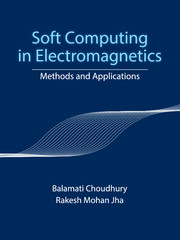Book contents
- Frontmatter
- Dedication
- Contents
- List of Figures
- List of Tables
- Preface
- Acknowledgments
- Abbreviations
- Symbols
- 1 Introduction
- 2 Soft Computing Techniques
- 3 Soft Computing in Electromagnetics: A Review
- 4 Bacterial Foraging Optimization For Metamaterial Antennas
- 5 PSO for Radar Absorbers
- 6 Characterization of Planar Transmission Lines Using ANN
- 7 Fault Detection in Antenna Arrays
- 8 Multi-Objective Particle Swarm Optimization for Active Terahertz Devices
- 9 Soft Computing based CAD Packages for EM Applications
- Author Index
- Subject Index
- References
7 - Fault Detection in Antenna Arrays
Published online by Cambridge University Press: 05 July 2016
- Frontmatter
- Dedication
- Contents
- List of Figures
- List of Tables
- Preface
- Acknowledgments
- Abbreviations
- Symbols
- 1 Introduction
- 2 Soft Computing Techniques
- 3 Soft Computing in Electromagnetics: A Review
- 4 Bacterial Foraging Optimization For Metamaterial Antennas
- 5 PSO for Radar Absorbers
- 6 Characterization of Planar Transmission Lines Using ANN
- 7 Fault Detection in Antenna Arrays
- 8 Multi-Objective Particle Swarm Optimization for Active Terahertz Devices
- 9 Soft Computing based CAD Packages for EM Applications
- Author Index
- Subject Index
- References
Summary
Modern day communication systems and other microwave systems like sonar, radar, etc., use antenna arrays for signal acquisition. Arrays allow the designer to attain highly directional patterns that can be steered in the required directions. These arrays are typically composed of a large number of elements. Due to the presence of this large number of elements, the probability of experiencing faults in some of the elements is very high. Consequently, diagnosis of faults in a large array is a problem that antenna engineers need to tackle often. These faults—elements that do not contribute to the radiation pattern—damage the pattern by increasing the sidelobe levels. Traditionally, engineers conduct measurements in the near field of the antenna in order to pinpoint the location of these faults [Lee et al., 1988; Migliore and Panariello, 2001; Bregains et al., 2005]. This technique is not feasible if the antenna is mounted on a remote system like a spacecraft and human access to the system is impossible [Lord et al., 1992]. Nonetheless, spacecraft antenna arrays either use test couplers or other calibration probes in the beam forming network, to detect failed elements and send the information to the ground using telemetry. These calibration probe based networks are very much complex and expensive [Bucci et al., 2000]. This brings about a need to devise methods to detect faults in antenna arrays by studying the far-field radiation pattern. In this chapter, soft computing is used to meet this objective, i.e., to detect faults in antenna arrays by studying the information obtained from its far-field radiation pattern.
Preliminaries and Overview
Failure of individual elements in an antenna array results in destruction of symmetry and often causes unacceptable distortion of the radiation pattern. Locating the defective elements in large arrays is a problem that is often described using the theory of inverse scattering. A practical solution to this problem may be obtained by installing sensors in the beam forming network. However, such a sensor network is often expensive and might be susceptible to the same faults that the elements succumb to [Bucci et al., 2000]. A simpler solution, therefore, is to study the far-field pattern of the antenna array and predict the location of these failures.
- Type
- Chapter
- Information
- Soft Computing in ElectromagneticsMethods and Applications, pp. 124 - 154Publisher: Cambridge University PressPrint publication year: 2016
References
- 2
- Cited by



